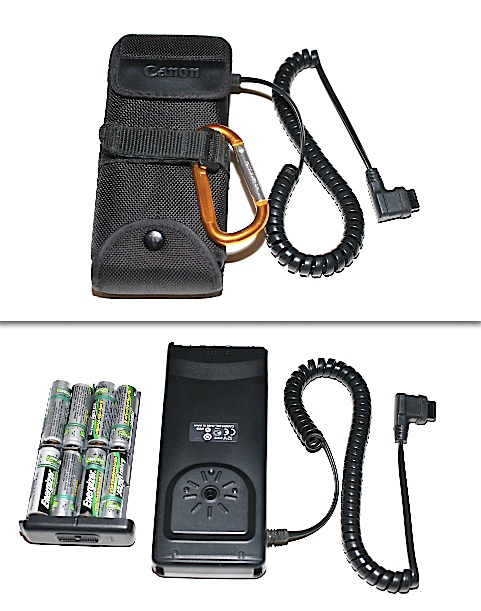|
7.4
Powering Your Flash Unit
As mentioned previously, external
flash units have an insatiable appetite for AA batteries. The
four AA’s that fit inside my flash unit’s battery compartment provide
enough power for relaxed shooting, but for intense shoots I require the
use of an external pack that holds an additional eight AA’s. The
external pack allows me to take more shots before needing to swap out
the batteries for a fresh set. It also reduces the recycle time of my flash.
This is the amount of time that it takes for the flash to recharge its
capacitor after a shot. If you try to take another shot before
the capacitor is fully re-charged, the flash unit will either fire at a
lower intensity (resulting in slight under-exposure) or may fail to
fire at all (possibly resulting in extreme under-exposure). By
shortening the recycle time of the flash head, the external battery
pack allows me to take successive shots closer together in time,
without risking under-exposure. Most flash units have a pilot light on the back of the
unit, which indicates when the capacitor is fully charged. If you
take a photo before the pilot has re-lit, the flash may or may not fire
at all, depending on the settings of the flash unit (and the
capabilities of that particular model). On some models you can
instruct the flash to fire at lower power if a photo is taken before
the pilot has re-lit, or you can instruct it to not fire at all until the pilot
lights up. Not all flash units offer the ability to fire before
the capacitor is recharged, however.
 Fig.
7.4.1 :
An external battery pack for flash. This pack costs about
Fig.
7.4.1 :
An external battery pack for flash. This pack costs about
$130 (US) nd holds eight AA's. The cord plugs directly into the
flash
unit. The use of such a unit allows more shots to be taken before
having to change batteries, and also reduces the recycle time between
shots. Note the carabiner clip in the top image; these clips are
cheap
and make it easier to clip/unclip the pack onto your strap or vest.
Fig. 7.4.2 :
The Squidmonster. Recharging many AA's simultaneously in a hotel
room
with few free electrical outlets requires a device like this.
Standard power strips pack
the outlets too close, so all five or six can't be used by multiple
chargers like these.
As already discussed in section 4.3, the use of
high-voltage battery
packs, such as those available from companies such as Quantum and the
like, are generally not recommended for use with flash units in the
field, since
they may void the flash unit’s warranty and may damage the flash by
providing more voltage to the flash’s circuitry than the flash was
designed to handle. Although others have had success with such
third-party battery packs, I’ve had several flash units destroyed this
way. In addition to the potential for dangerously high voltage,
the use of external packs (even those made by the camera’s OEM) can
potentially cause a meltdown
(see section 7.10 for tips on avoiding a
meltdown).
|
|
|
